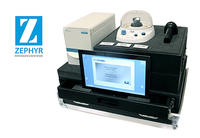-
Battelle shows smart technology for biodefense and hazard avoidance
Battelle last week announced production of the next generation chemical and biological hazard sensor system, which the company says operates at a fraction of the cost of current technologies. The technology, known as the Resource Effective BioIdentification System (REBS), is a battery-powered system capable of autonomous use with operating costs of less than $1 per day per unit (the company notes that current system costs that can range from $500 - $3,000 per day) and assay costs of $0.04 per sample (compared to current systems at over $100 per sample).
-
-
Attackers exploited Microsoft security hole before company’s announcement
Before Microsoft alerted its customers of a security flaw in Windows XP over a week ago, a group of advanced hackers had already discovered and used the vulnerability against targeted financial, energy, and defense companies.
-
-
U.S. military communication satellites vulnerable to cyberattacks

A new report warns that satellite communication terminals used by U.S. military aircrafts, ships, and land vehicles to share location data, are vulnerable to cyberattacks through digital backdoors. A forensic security review of codes embedded inside the circuit boards and chips of the most widely used SATCOM terminals identified multiple hacker entry points.
-
-
First large-scale dengue vaccine efficacy study achieves primary clinical goals
Dengue is a threat to nearly half the world’s population, and is a pressing public health priority in many countries in Asia and Latin America where epidemics occur. Sanofi Pasteur, the vaccines division of Sanofi, yesterday announced that the first of two pivotal Phase III efficacy studies with its dengue vaccine candidate has achieved its primary clinical endpoint. The efficacy study showed a significant reduction of 56 percent of dengue disease cases. The study involved more than 10,000 volunteers from Asia.
-
-
PathSensors introduces portable pathogen identifier system

Baltimore, Maryland-based PathSensors, Inc. has introduced the portable Zephyr Pathogen Identifier system. The company says it delivers rapid, reliable detection of bacteria, virus, and toxins in powder and liquid samples in minutes. The Zephyr Identifier uses CANARY (Cellular Analysis and Notification of Antigen Risks and Yields) technology, which is licensed from the MIT-Lincoln Laboratory.
-
-
Adoption of battlefield surveillance system in urban settings raises privacy concerns
More cities are adopting an aerial surveillance system first developed for the military. The surveillance cameras, fitted on a small plane, can record a 25-square-mile area for up to six hours, and cost less than the price of a police helicopter. The system also has the capability of watching 10,000 times the area that a police helicopter could watch. Privacy advocates are concerned. “There are an infinite number of surveillance technologies that would help solve crimes, but there are reasons that we don’t do those things, or shouldn’t be doing those things,” said one of them.
-
-
Silent-capable hybrid-electric military motorcycle
Fairfax, Virginia-based Logos Technologies has received a small business innovation research (SBIR) grant from DARPA to develop a military-use hybrid-electric motorcycle with near-silent capability. The company says that when fully matured, the technology will allow small, dispersed military teams to move long distances quickly and stealthily across harsh enemy terrain.
-
-
Debate over closing NY’s Indian Point nuclear power plant intensifies
Indian Pointnuclear power plant, just thirty miles from New York City, has presented a conundrum for environmentalists who advocate clean-air initiatives, caps on carbon emissions, and increasing investment in non-polluting renewable energy sources — but at the same time argue that nuclear power poses a safety hazard to the surrounding area and demand that Indian Point cease operations. Closing the plant would require a long-term energy strategy to replace the 2,000 megawatts the plant currently produces.
-
-
CBP takes another stab at high-tech border security

The George W. Bush administration’s effort to build a high-tech border security system – the Boeing-led SBINet – was a failure, and the Obama administration shut it down in 2011. CBP is now trying again, this time with Elbit Systems as the lead contractor. The hope is that the lessons of the doomed SBINet, and Elbit’s experience in building high-tech defensive systems along Israel’s borders, would yield better result this time around.
-
-
Positive results reported from single dose anthrax vaccine studies

Immunovaccine and Pfenex announced positive results from anthrax challenge studies in rabbits using Pfenex’s mutant recombinant Protective Antigen (mrPA) formulated with Immunovaccine’s DepoVax delivery system. Data demonstrates 100 percent protection against a lethal anthrax challenge in animals after vaccination with as little as 0.33 microgram of mutant recombinant Protective Antigen. Dose response observed in the first twenty-eight days following vaccination.
-
-
U.S. corporations aware of current, future water risks
A new survey shows that nearly 60 percent of responding companies — the majority Fortune 500 and publically traded, representing virtually every industry sector — indicated that water is poised negatively to affect business growth and profitability within five years, while more than 80 percent said it will affect their decision on where to locate facilities. This is a stark increase from only five years ago, when water issues affected business growth and profitability for less than 20 percent of responding companies.
-
-
DHS hits reset button on the Electronic Immigration System (ELIS)
DHS has awarded InfoZen 3-year, $11.9 million contract — the first of multiple contracts — for the Electronic Immigration System (ELIS), designed to process immigration forms. This is the latest attempt to digitize the processing system after spending roughly $1 billion and five and a half years under a contract led by IBM. IBM’s “design is poorly thought through and inconsistently applied by the developers. The result is duplication of efforts, time spent on rework, slowness in debugging problems, poor quality code, etc.,” said CIS chief information officer Mark Schwartz.
-
-
World record in high altitude wind turbine set to be broken
Boston, Massachusetts-based Altaeros Energies, a wind energy company formed out of MIT, said its Alaska demonstration project is set to break the world record for the highest wind turbine ever deployed. The $1.3 million, 18-month project will deploy the Altaeros BAT at a height 1,000 feet above ground. At that height, the BAT commercial-scale pilot project in Alaska will be over 275 feet taller than the current record holder for the highest wind turbine, the Vestas V164-8.0-MW. Investment into the high altitude wind sector has recently gained momentum with several large acquisitions.
-
-
Facebook making snooping more difficult
Facebook has joined its Silicon Valley competitors to improve cybersecurity following a recent report suggesting that the NSA may have posed as Facebook to infect targeted computers. Joe Sullivan, Facebook’s chief security officer, said Facebook was working to “make sure the system is robust enough that everyone should be coming in the front door with legal process and not getting information any other way.” He added that no one could pose as Facebook servers any more since the company made “https,” a secure method of accessing Web pages, standard last year.
-
-
U.S. lags behind other countries in commercial use of drones
As the United States continues to explore regulations and safety guidelines for commercial UAVs, other countries have already adopted their use. Photographers, real estate agents, filmmakers, and news agencies in the United States want to use drones in their operations, but the FAA insists that rules addressing safety challenges associated with drones need to be in place before drones can share the sky with manned aircrafts.
-
- All
- Regional
- Water
- Biometrics
- Borders/Immig
- Business
- Cybersecurity
- Detection
- Disasters
- Government
- Infrastructure
- International
- Public health
- Public Safety
- Communication interoperabillity
- Emergency services
- Emergency medical services
- Fire
- First response
- IEDs
- Law Enforcement
- Law Enforcement Technology
- Military technology
- Nonlethal weapons
- Nuclear weapons
- Personal protection equipment
- Police
- Notification /alert systems
- Situational awareness
- Weapons systems
- Sci-Tech
- Sector Reports
- Surveillance
- Transportation
Advertising & Marketing: advertise@newswirepubs.com
Editorial: editor@newswirepubs.com
General: info@newswirepubs.com
2010-2011 © News Wire Publications, LLC News Wire Publications, LLC
220 Old Country Road | Suite 200 | Mineola | New York | 11501
Permissions and Policies
Editorial: editor@newswirepubs.com
General: info@newswirepubs.com
2010-2011 © News Wire Publications, LLC News Wire Publications, LLC
220 Old Country Road | Suite 200 | Mineola | New York | 11501
Permissions and Policies
